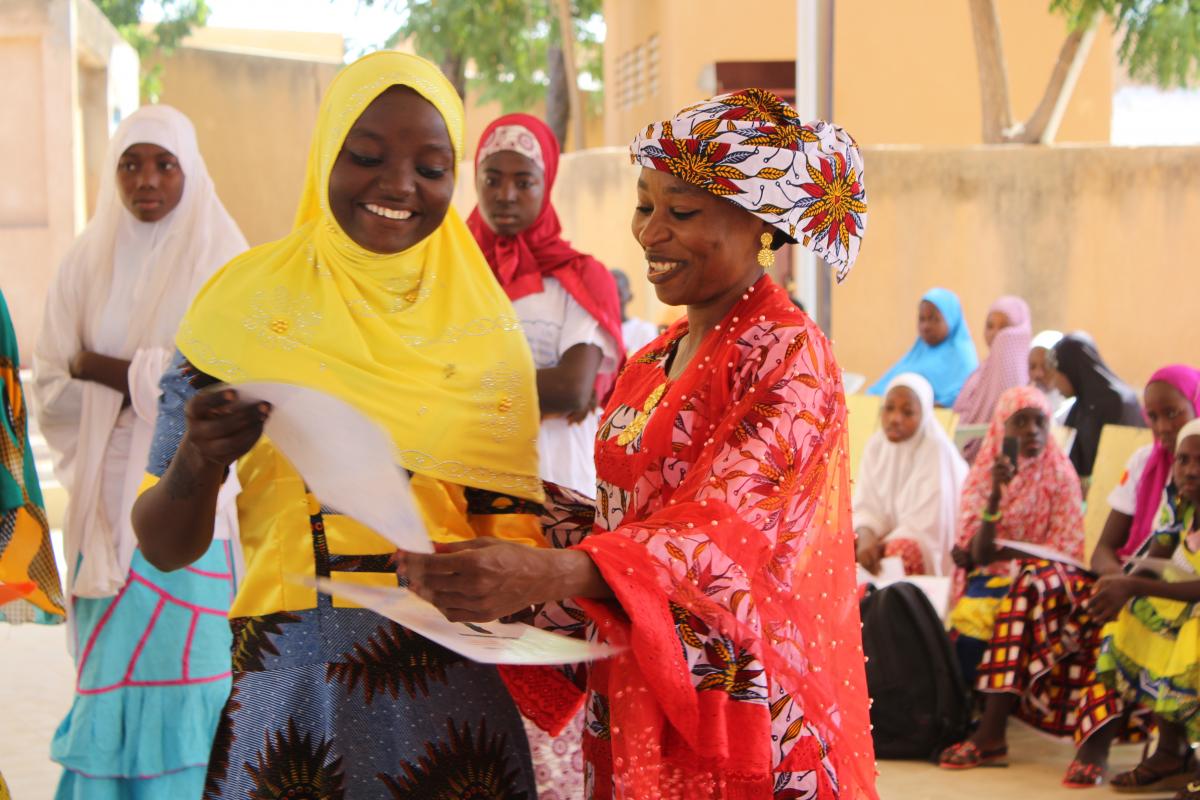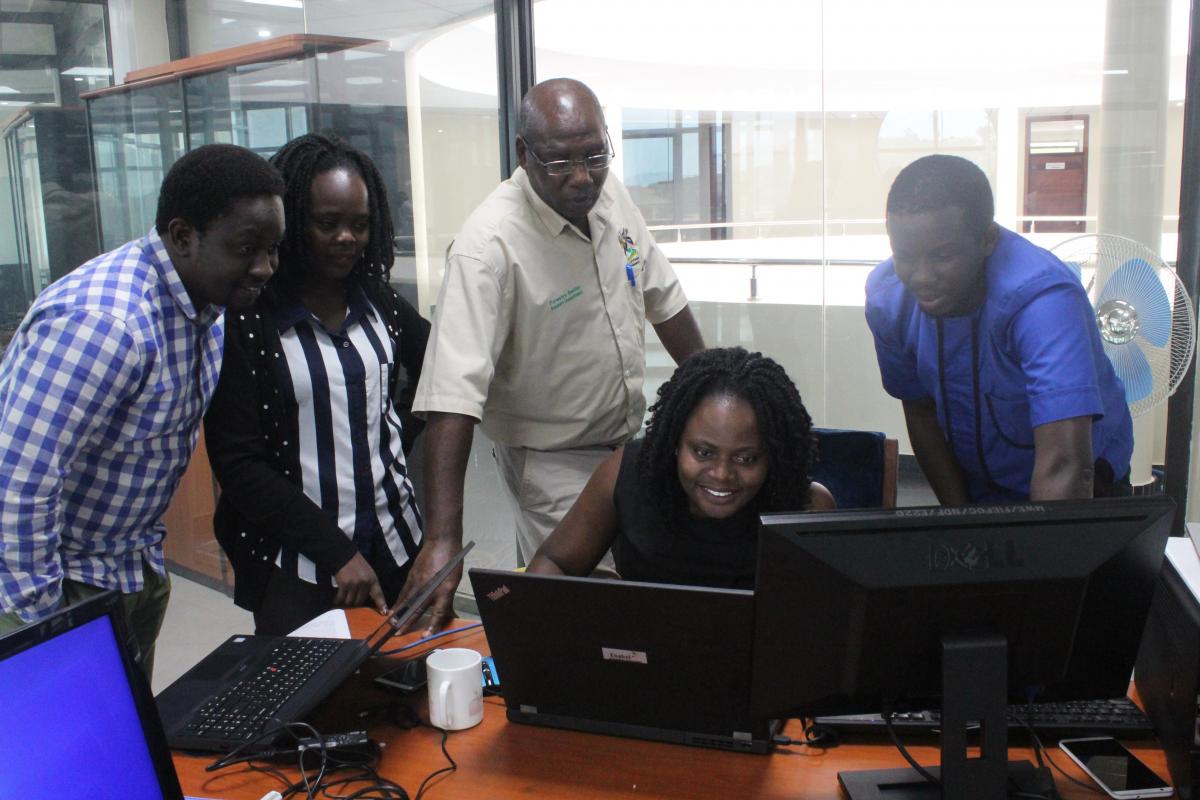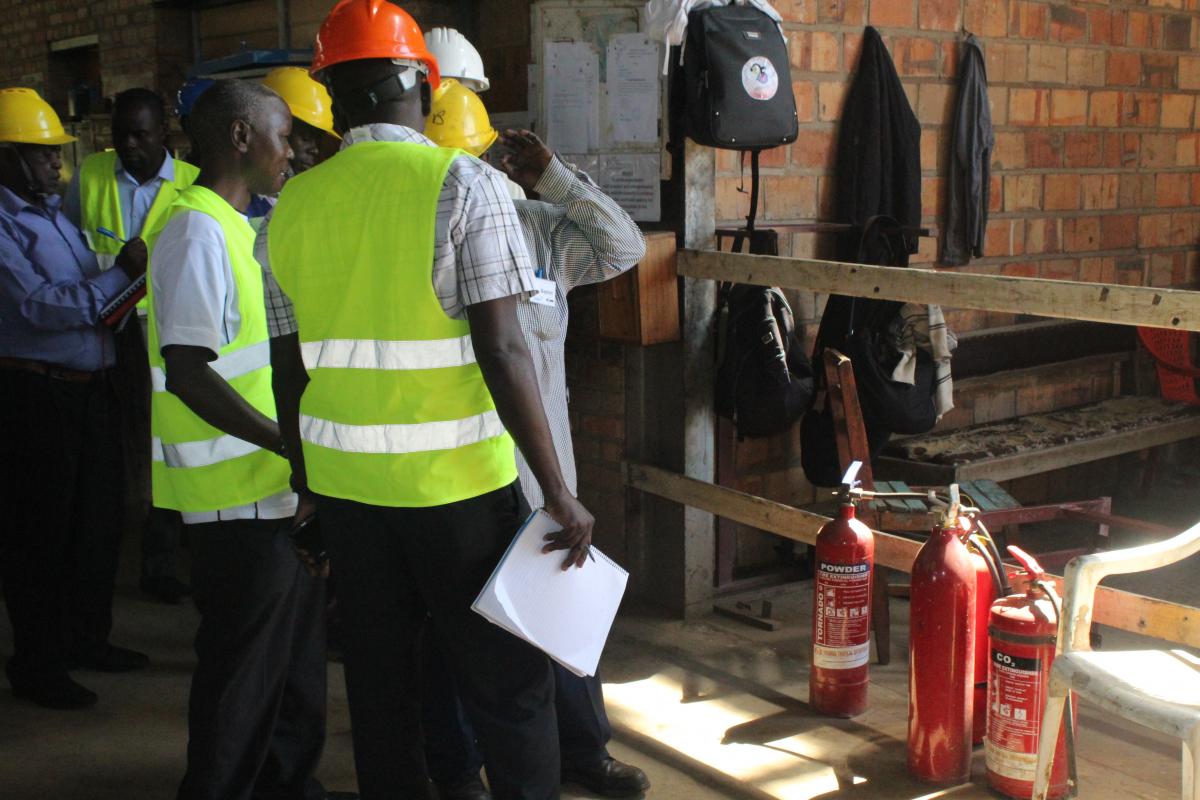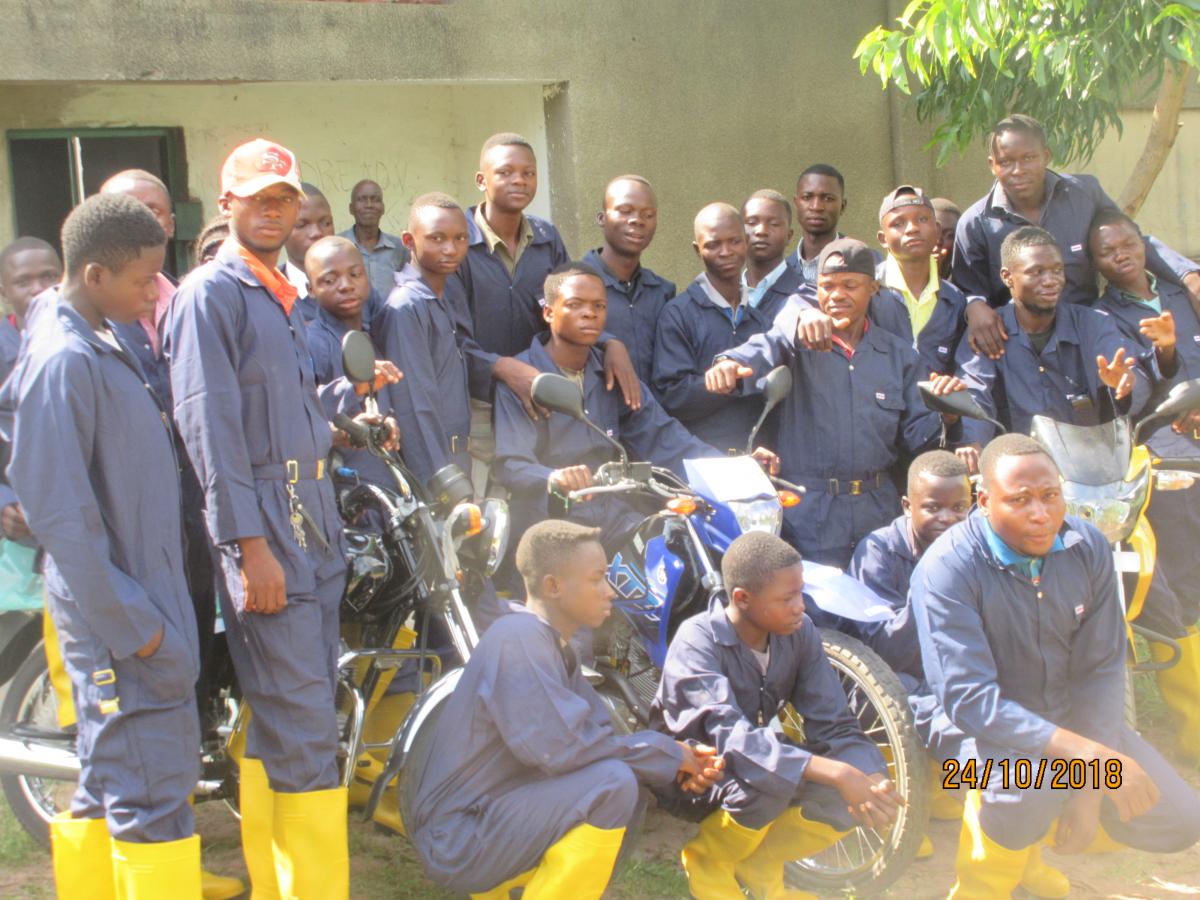Search
Viewing 2370 to 2385 of 3055 news
-
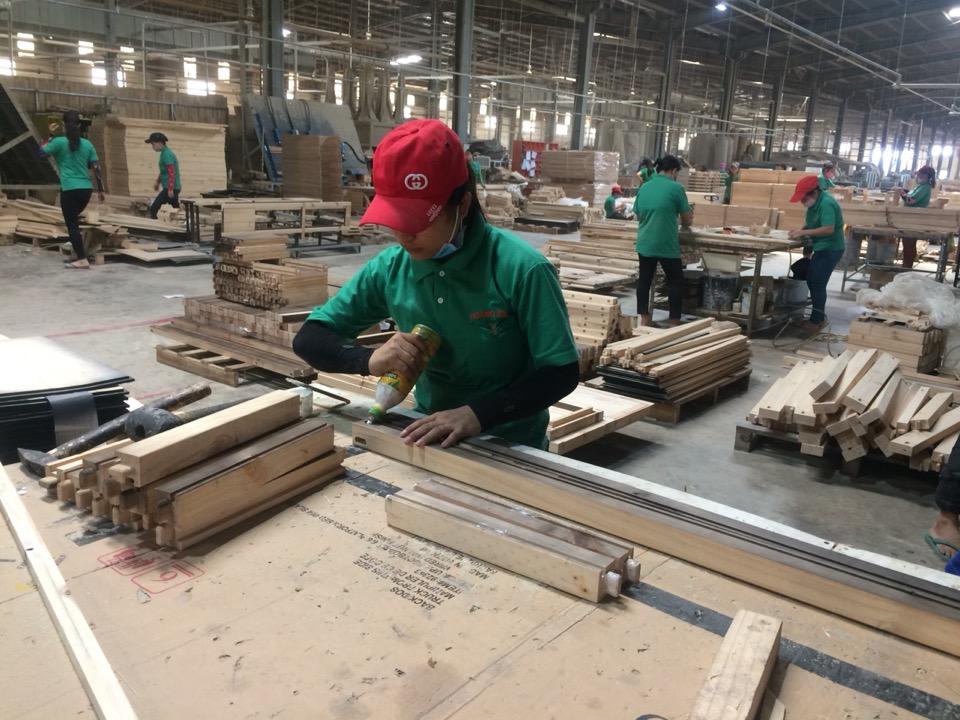
Youth Union - a job broker
Marion FISCHER | 28/11/2018
On November 2, 2018 the youth union activists of Dak Bla commune in Kon Tum province held one of a series of trainings for young people helping their peers in finding jobs or establishing a start-up. The program is run with the employment services und includes the organization of job fairs for the young in the communes. As a result of the latest series of job fairs, 75 job placements of young people were achieved in one newly established enterprise branch alone. This enterprise provides on-the-job training, living space, a canteen and even a kindergarden for the young workers. There are also hundreds of interesting job offers brokered for labour in Korea, Japan and other countries. The provincial Department of Labour and Social Affairs provides financial aid for the new workers and/or settlement in a job abroad.
-
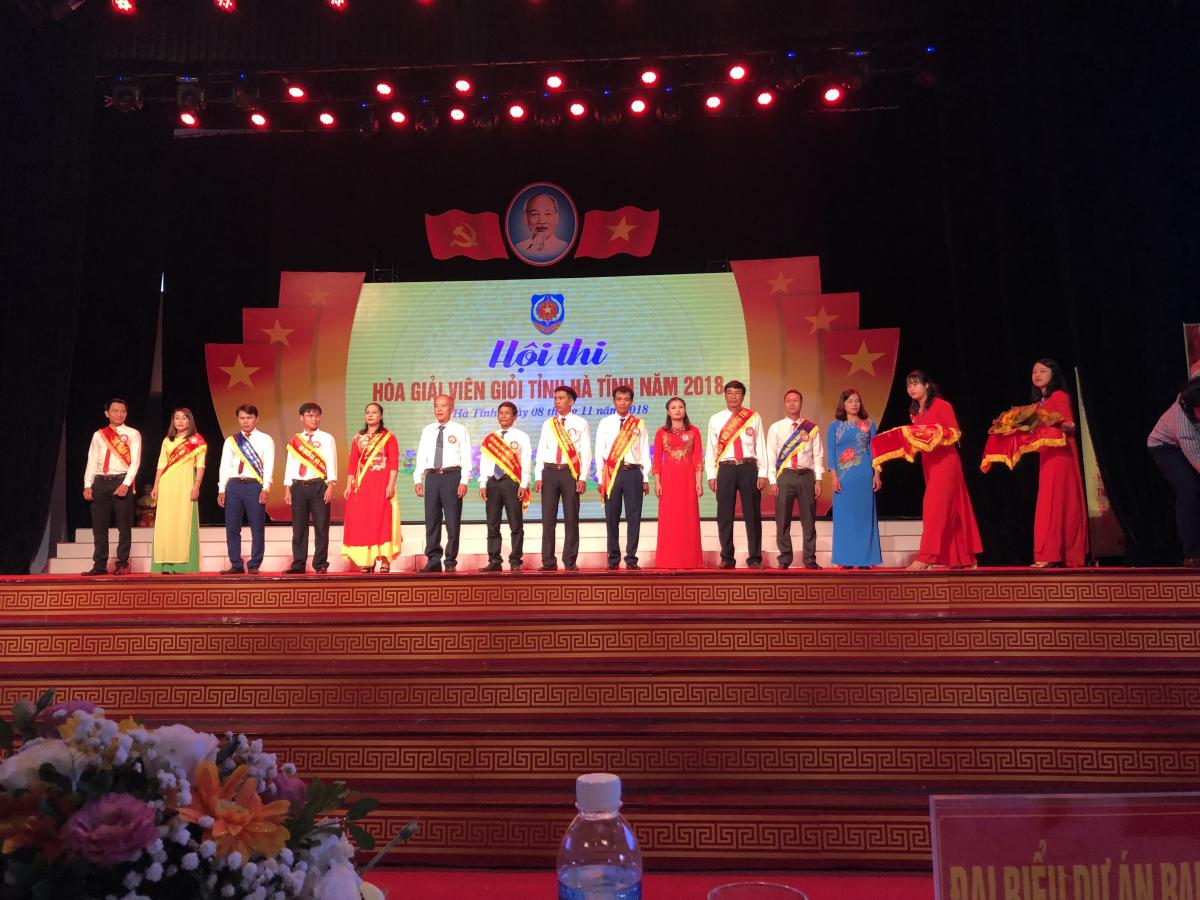
Success for access to justice programme
Marion FISCHER | 28/11/2018
On November 8, 2018 the final event of the province-wide contest of legal mediators was held in Ha Tinh. The winning teams of the districts presented their achievements in helping people to solve civil legal disputes in a spirit of observing state of law and social cohesion. All teams demonstrated impressive legal knowledge and demonstrated examples of their work. The mediators contribute effectively to access to justice for all people and to the improvement of two-way dialogue between the people and the government at all levels.
-
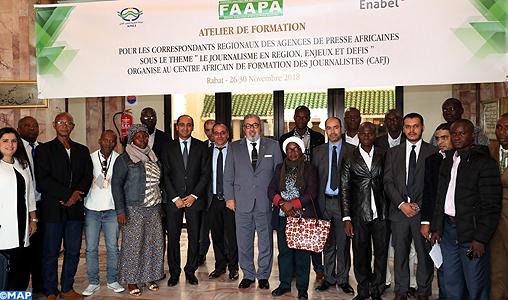
Le rôle stratégique des journalistes dans l’information de proximité
Meriem HILALI | 27/11/2018
Lancement lundi 26 novembre à Rabat d’un atelier de formation pour les correspondants régionaux des agences de presse africaines sous le thème « le journalisme en région : enjeux et défis » et ce dans le cadre du Fonds d’Appui à la coopération triangulaire (Maroc-Belgique-autres pays africains). L’objectif du Fonds, mis en œuvre par l’AMCI et Enabel, est de promouvoir des actions et des échanges dans les domaines de la formation et du transfert du savoir-faire pour l’amélioration des compétences des ressources humaines des pays d’Afrique subsaharienne. Plusieurs modules seront discutés lors de cet atelier comme les enjeux professionnels du journalisme en région, les défis du journalisme en région : leçons et expériences, l’instantanéité de l’information régionale, les différents types de sources d’information, la programmation ou la planification éditoriale en région, le fact-checking ou vérification des faits, les techniques d’écriture pour le web, l’usage des réseaux sociaux, les principes de l’éthique professionnelle et de la déontologie journalistique, les mécanismes de motivation et les critères d’évaluation. La formation se déroulera jusqu’au 30 de ce mois au profit de 15 pays partenaires, à savoir : Bénin (Agence Bénin Presse - ABP), Burkina-Faso (Agence d’Information du Burkina - AIB), Cap Vert (Agence Capverdienne de Presse - INFORPRESS), R. Centrafricaine (Agence Centrafricaine de Presse - ACAP), Congo Brazzaville (Agence Congolaise d’Information – ACI, RDC (Agence Congolaise de Presse -(ACP), Côte d’Ivoire (Agence Ivoirienne de Presse - AIP), Gabon (Agence Gabonaise de Presse - AGP), Guinée (Agence Guinéenne de Presse - AGP), Guinée-Bissau (Agence de Presse de la Guinée-Bissau - ANG), Maroc (Agence Marocaine de Presse - MAP), Mauritanie (Agence Mauritanienne d'Information - AMI), Niger (Agence Nigérienne de Presse - ANP), Sénégal (Agence de Presse Sénégalaise - APS), Tchad (Agence Tchadienne de Presse et d’Edition - ATPE), Togo (Agence Togolaise de Presse - ATOP).Lien presse : https://goo.gl/cFJ3DY
-
Deuxième édition de la Compétition Sarraounia : "Engageons-nous toutes et tous en faveur de l'égalité des chance dans l'enseignement secondaire"
Céline MEWISSEN | 26/11/2018
Le 24 novembre a eu lieu la deuxième édition de la compétition Sarraounia. Des attestations et prix ont été remis aux élèves les plus méritants des six collèges d’intervention du projet. L’exemple du collège de Malam Koira, établissement qui a vu la réussite de 100% des élèves filles inscrites au BEPC en 2018 a été salué par l’ensemble des participants. Les parents d’élèves, directeurs, comités de gestion des établissements scolaires et leaders religieux les plus engagés envers la scolarisation des filles dans leur communauté ont également été récompensés. Ainsi que le Directeur régional des enseignements secondaires (DRES) de Dosso l’a souligné, l’enjeu est double. Tout d’abord, stimuler l’émulation afin de pousser les élèves à se dépasser dans leurs études mais également et avant tout, améliorer la perception des parents et des communautés rurales sur les bénéfices de la scolarisation de la jeune fille. Il a appelé l’ensemble de la communauté à « s’engager en faveur de l’égalité des chances dans l’enseignement secondaire. Ainsi, en le faisant, nous n’apportons pas seulement notre contribution à l’atteinte des objectifs du Projet Sarraounia mais nous contribuons surtout à améliorer les perspectives d’avenir des jeunes filles scolarisées dans les six collèges ruraux pilotes. Je demeure convaincu que l’éducation constitue la meilleure opportunité pour ces filles elles-mêmes, leur famille et leur communauté.»
-
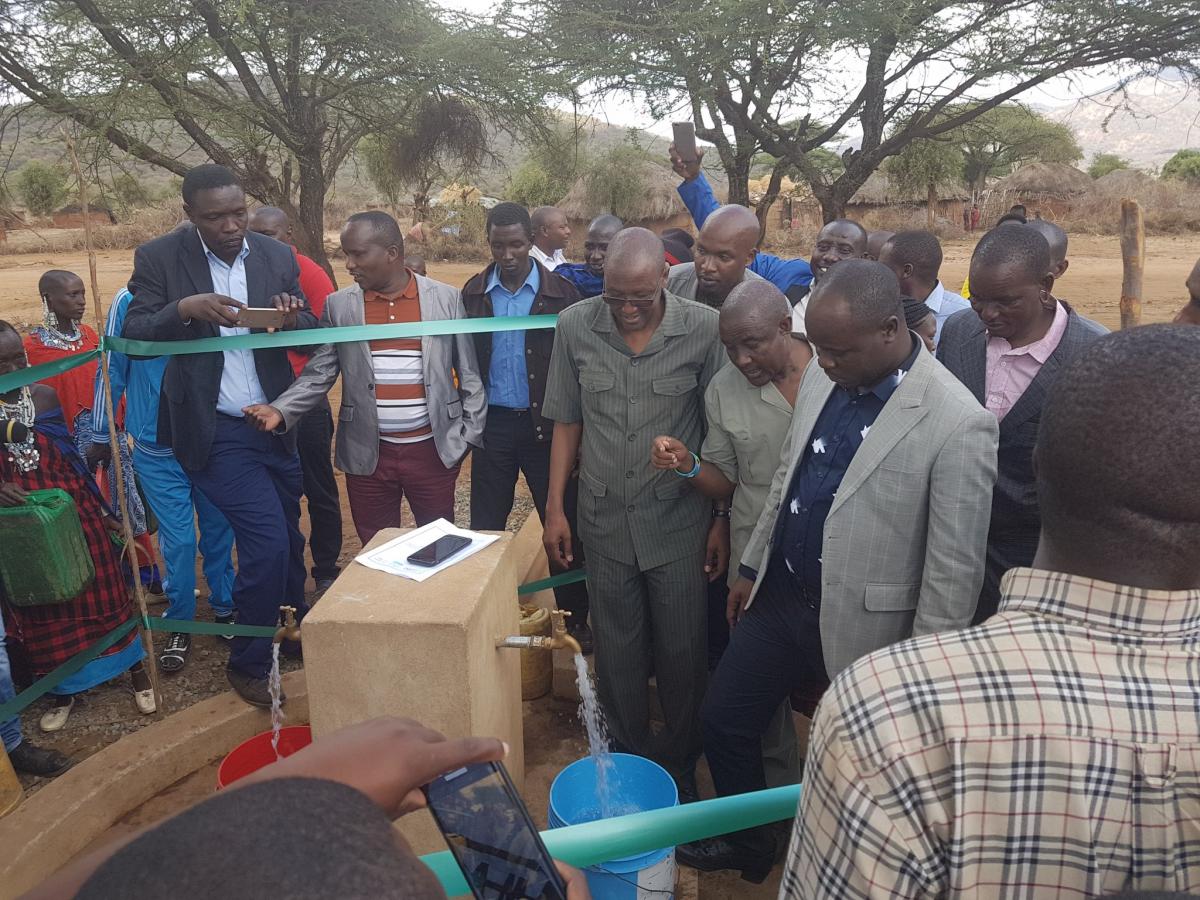
New life saving water infrastructure in Northern Tanzania
Mathias LARDINOIS | 26/11/2018
Deputy Minister of Water and Irrigation Jumaa Hamidu Aweso inaugurating the new water infrastructure in Matale A (Region of Arusha). He expressed his great appreciation to #Belgium represented by @Enabel_Belgium for the program and @IlesDePaix for the water component.It is the first time this remote village close to the border with Kenya (in the District of #Longido) will have water available all year round, directly at the village center, the clinic and the school.It allows to give water to livestock with @VSF_Belgium, to grow vegetables at school and to help hygiene at school and at the clinic with @WFP_Tanzania @childreachtz and it frees time for developing business with @Triasngo.This is a huge improvement in their life, made possible thanks to the very good #partnership with our local partner #LCDO, the Tanzanian authorities (Village, District, Region and National) and @BelgiumTanzania.
-

Más de 7000 personas se afiliaron al Seguro Integral de Salud en Cajamarca
Guido COUCK | 23/11/2018
Programa SISTEC presentó logros alcanzados tras 5 años impulsando los servicios de calidad y cultura de aseguramiento universal en salud en Cajamarca.8 establecimientos de salud implementaron planes de mejora en la atención a la población más vulnerable.Cajamarca, 16 de noviembre 2018.- El Programa de Apoyo a la Política de Aseguramiento Universal en Salud en el Perú a través del SIS – SISTEC, implementado por la Agencia Belga de Desarrollo – CTB/Enabel y el Seguro Integral de Salud (SIS), dio a conocer hoy viernes 16 a la población de Cajamarca los resultados de sus actividades así como la sostenibilidad de las mismas. El SISTEC viene operando desde el año 2014 y es financiado por la Cooperación Belga con el propósito de contribuir a la mejora de los servicios de salud de la población en situación de pobreza y pobreza extrema y la promoción de derechos y deberes en salud y cultura de aseguramiento y ha venido ejecutándose en San Martín, Piura, Junín y Huancavelica, además de en nuestra región, a través del trabajo articulado con actores regionales para el aseguramiento universal en salud.Album de fotos : https://www.flickr.com/photos/163831884@N05/albums/72157700545822792/page1/La Cooperación Belga junto al SIS, a través del programa SISTEC, pudieron generar los siguientes logros en lo que respecta a la salud de la población en la región:10 IPRESS priorizadas realizaron autoevaluación para la mejora de procesos, 8 de ellas implementaron su primer Plan de Mejora, y 71 profesionales de salud fueron capacitados en evaluación de estándares con la metodología LEAN SIX SIGMA.1 Comité Regional y 4 Comités Locales de Intercambio Prestacional conformados para articular los establecimientos de salud del gobierno regional con las Redes Asistenciales de EsSalud para lograr una Red Integrada de Servicios de Salud.4 Oficinas de Unidad Desconcentrada regional (UDR) del SIS y 4 Oficinas de Atención al Asegurado (OAA) fueron implementadas en la región, alcanzando atender a 45,697 personas y generar 7,029 afiliaciones al SIS en los últimos tres años (2016-2018).10,973 personas recibieron información y asistencias técnica sobre procesos de afiliación, derechos y deberes en salud a través de 149 campañas y charlas de difusión de deberes y derechos, sesiones informativas acerca del SIS y canales de reclamo.229 profesionales de la DIRESA, UDR y agentes comunitarios formados en derechos y deberes de salud, con enfoque participativo de educación popular; y 127 planes de réplica implementados para fortalecer las capacidades de más familias alcanzando a 2,470 personas de la región Cajamarca.El embajador del Reino de Bélgica, S.E. Sr. Koenraad Lenaerts, declaró que “El apoyo de la Cooperación Belga se ha venido produciendo en los últimos 5 años en Cajamarca como unas de las regiones más privilegiadas. Siendo la salud uno de los temas priorizados por la Cooperación, éste también ha sido abordado en la región gracias al esfuerzo interinstitucional realizado junto al SIS, SUSALUD, DIRESA y el GORE para proveer el aseguramiento universal de salud a la población más vulnerable”.Por otro lado, la Dra. Doris Lituma, Jefa del SIS, destacó que “El trabajo conjunto ha permitido contar con mayor cobertura en la región Cajamarca, siendo Cutervo, por ejemplo, una de las zonas donde se tiene el 90% de población asegurada”. Así mismo informó que las mejoras implementadas en la calidad de atención de salud permitieron disminuir dos puntos del índice de anemia en la región Cajamarca. Finalmente agradeció a la Cooperación Belga por la transferencia de conocimientos, competencias, tecnología y el apoyo financiero en las acciones de información de los deberes y derechos de salud tanto como en las mejoras de la calidad de atención a la población más vulnerable.Junto a S.E. Sr. Koenraad Lenaerts, embajador del Reino de Bélgica, el evento contó con la participación de personajes internacionales como Patrick Gaudissart, Representante Residente de Agencia Belga de Desarrollo – CTB/Enabel y Dr. Luc Geysels, Co-director Internacional Programa SISTEC. Así mismo resaltó la presencia de representantes nacionales y regionales de las instituciones vinculadas al desarrollo del Programa SISTEC como César Aliaga Díaz, Gerente de Desarrollo Social - GORE Cajamarca; MC.; Dr. Rubén Figueroa, representante de SUSALUD además de diversos representantes de la DIRESA Cajamarca, UDR Cutervo, UDR Cajamarca, MCLCP, GORE Cajamarca e instituciones participantes y/o vinculadas al Programa.Posteriormente se realizó la segunda parte del evento en Hospital Regional de Cajamarca, donde se implementó una de las OAA. El Jefe de la UDR, Abel Monteza, declaró que “A través de esta Oficina de Atención al Asegurado se brinda información permanente sobre los beneficios del SIS. Cuenta con personal capacitado para resolver consultas y garantizar el ejercicio de los derechos de la población cajamarquina en salud y atención de calidad.
-
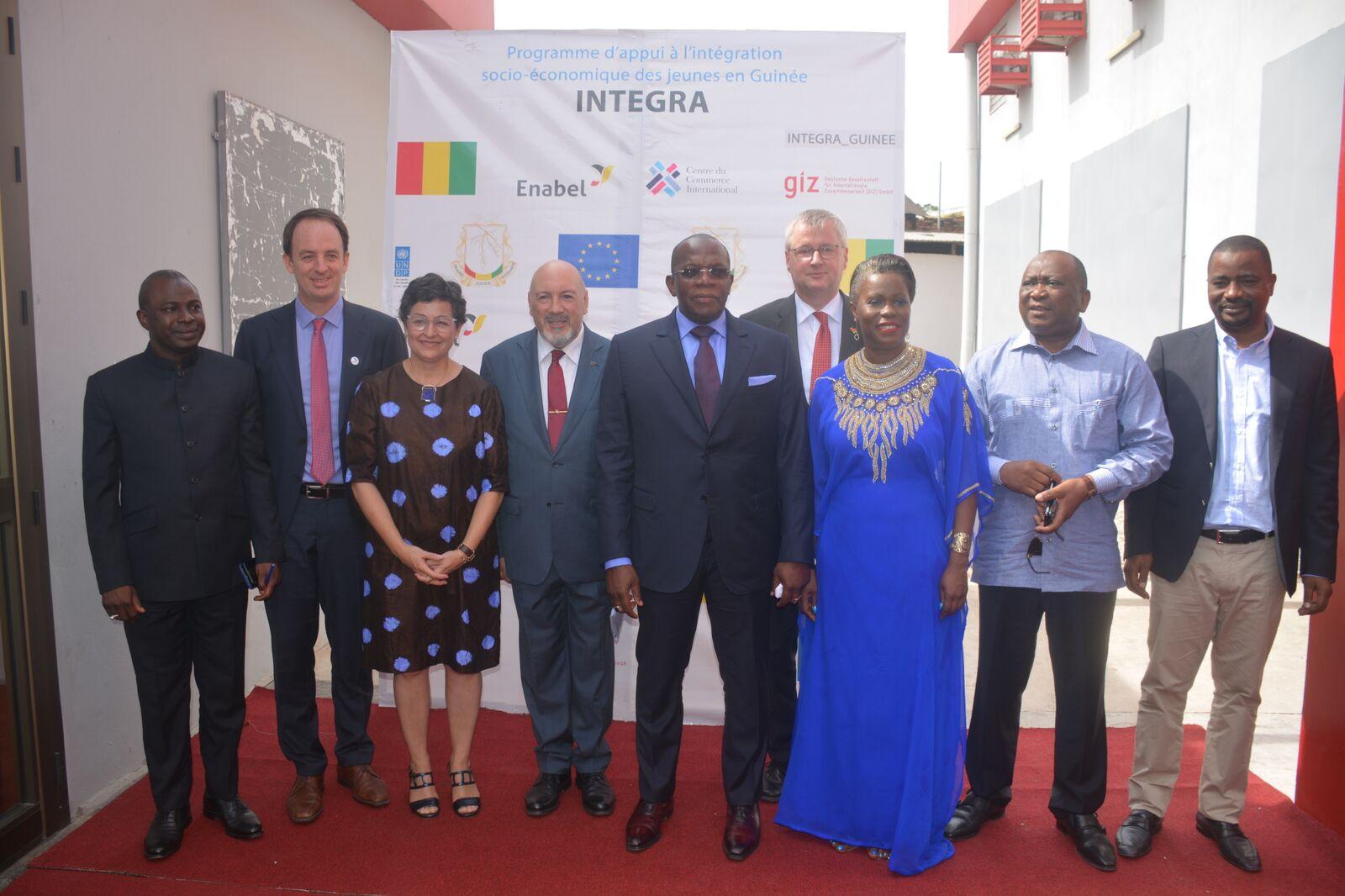
La Guinée et l’Union européenne font appel à Enabel pour la mise en œuvre du programme INTEGRA
Guido COUCK | 22/11/2018
Conakry, le 19 novembre 2018 - La République de Guinée et l’Union Européenne ont lancé le 19 novembre 2018 le Programme d’appui à l’intégration socio-économique des jeunes (INTEGRA) à Conakry.Le lancement a été présidé par le Premier Ministre de la République de Guinée, Dr Ibrahima Kassory Fofana. L’Union européenne était représentée par l'Ambassadeur de l'UE en Guinée, Josep Coll. De nombreux officiels étaient également conviés à cet évènement, parmi lesquels il convient de signaler la présence de la Directrice exécutive du Centre du commerce international (ITC), Arancha Gonzalez, du Directeur général d’Enabel, Jean Van Wetter, de l’Ambassadeur de la République fédérale d’Allemagne, Matthias Veltin.Face au phénomène migratoire qui soustrait au pays des pans importants de son capital de talent et de travail, le Gouvernement de Guinée considère la promotion de l’emploi jeune et la création d’opportunités économiques des priorités absolues. En collaboration étroite avec les autorités, l'Union européenne a décidé de financer d'un montant de 65 millions d'euros à travers son Fonds fiduciaire d’urgence en faveur de la stabilité et de la lutte contre les causes profondes de la migration irrégulière et du phénomène des personnes déplacées en Afrique (Fonds fiduciaire de l’UE pour l’Afrique) la mise en œuvre du Programme d'appui à l'intégration socio-économique des jeunes (INTEGRA). Aligné sur le Plan national de développement économique et social (PNDES) et sur les politiques sectorielles du Gouvernement guinéen, ce programme contribuera au développement économique de la Guinée pour favoriser l'insertion socio-professionnelle des jeunes guinéens. En appuyant les politiques nationales mises en place pour favoriser l’emploi jeune, le programme INTEGRA se veut une contribution pour amorcer des nouvelles dynamiques pour le développement socio-économique harmonieux de la République de Guinée.Initié conjointement par le Gouvernement guinéen et l'Union européenne, ce Programme créera des opportunités pour la jeunesse guinéenne à travers la préparation à la vie professionnelle dans les écoles, la réalisation d’infrastructures économiques en haute intensité de main d’œuvre, la formation professionnelle, la création d’emplois durables et le développement de l’entrepreneuriat en Guinée.INTEGRA poursuit les objectifs suivants :La promotion d’opportunités économiques et d’emplois durables à destination des jeunes en créant des emplois à travers le travail à haute intensité de main d’œuvre (HIMO) contribuant à la mise en œuvre des plans de développement au niveau local.Les jeunes auront également accès à une formation professionnelle de plusieurs mois et à une préparation à la vie professionnelle. Les apprenants sont ainsi professionnalisés dans les filières à fortes débouchées en Guinée tel que l’agriculture, la construction, ou encore les technologies de l’information et de la communication. Ces formations ont pour but d’améliorer leur employabilité sur le marché guinéen, contribuant ainsi à l’insertion socio-économique de ces jeunes à travers l’emploi.Promouvoir l’entreprenariat chez les jeunes tout en les aidant d’une part, à lancer des activités novatrices génératrices de revenus et d’autre part, à consolider leurs activités entrepreneuriales à travers des appuis techniques et financiers qui visent à favoriser le développement et la création de richesses. INTEGRA encadrera les jeunes entrepreneurs après le financement de leur entreprise dans l’exécution de leur plan d’affaires, et en assistant les entreprises bénéficiaires dans les différentes étapes de leur croissance afin de s’assurer de leur viabilité et leur développement.La sensibilisation des publics cibles, en particulier les jeunes, aux opportunités du programme, au danger de la migration irrégulière et au potentiel de la Guinée afin de renforcer leur rôle en tant qu’acteurs et bénéficiaires du programme.Pour la mise en œuvre des actions prévues par INTEGRA, le Gouvernement guinéen et l’Union européenne ont fait appel à l'expertise de trois agences pour la mise en œuvre du projet, à savoir, l’agence belge de développement (Enabel), le Centre de Commerce Internationale (CCI), et l'agence de coopération internationale allemande pour le développement (GIZ). Ces trois agences travaillent en synergie et en étroite collaborations avec les trois ministères de tutelle concernés.Lors de son discours d’ouverture de cérémonie, le Premier Ministre de la République de Guinée, Dr Ibrahima Kassory Fofana, a mis l’accent sur l’importance de la place des jeunes dans ce programme : « Nous voulons de manière générale soutenir des projets qui contribuent à construire un territoire dynamique où l’on peut entreprendre, où les jeunes s’épanouissent et où les forces s’unissent pour lutter contre l’émigration. Grâce au partenariat engagé entre le gouvernement Guinéen et l’Union européenne, nous allons accompagner les jeunes guinéens dans leur parcours d’insertion socio-économique à travers des outils ou méthodes que nous avons voulus innovantes, concrètes et efficaces. C’est une très grande satisfaction que de participer à ce projet. »De son côté, l'Ambassadeur de l'Union européenne en Guinée, Josep Coll, a déclaré : « INTEGRA veut amorcer une nouvelle dynamique dans la création d’emploi et dans le soutien de l’entrepreneuriat jeunes. En même temps, j’aimerais souligner que ce programme se veut un premier accompagnement de l’Union européenne du Gouvernement de la Guinée dans la mise en œuvre de ses priorités politiques en la matière. Le caractère innovateur d’INTEGRA devrait permettre d’amorcer cette dynamique. » Ainsi, à travers ce programme, ce sont plus de 15.000 jeunes qui seront directement accompagnés par le projet INTEGRA pour amorcer cette nouvelle dynamique pour l’intégration socio-économique, pour travailler, entreprendre et réussir en Guinée.
-

Ouverture officielle Coopérative commerciale - COLUCAAB
Aimé GIRUKWIGOMBA | 20/11/2018
Publie-reportage RTNB
-
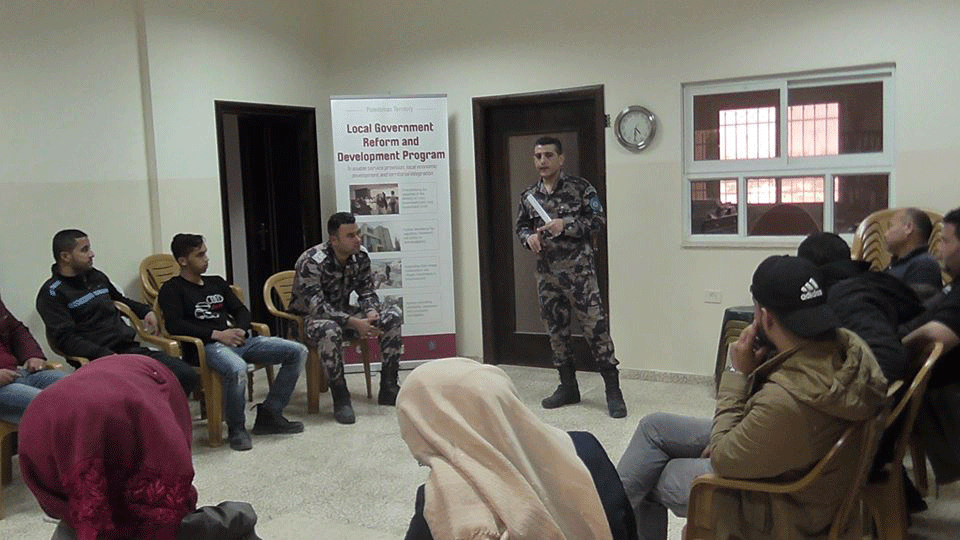
Training for volunteers in Beit Leqya
Laura SCHILLEMANS | 20/11/2018
To motivate youth to be active in the Joint Service Council (JSC) activities, and to raise their capacities in social voluntarism, the Beit Leqya JSC implemented 2 trainings for the volunteers of the cluster. 17 volunteers actively participated in the civil defense training and 30 in the first aid training. The civil defense training included a practical training on firefighting and on earthquake safety, with a focus on protection and evacuation. The first aid training explained how to prevent diseases, minimize chances to have an accident, perform CPR and how to deal with broken bones, burns and snake bites. This activity was funded by the Local Government Reform and Development Program - phase 2, implemented by the Ministry of Local Government, Municipal Development and Lending Fund and funded by the Belgium Government through Enabel.
-
Apoyo a la política de Aseguramiento Universal en Salud
Guido COUCK | 15/11/2018
El Programa SISTEC tiene como objetivo contribuir a la mejora de servicios de salud de la población en situación de pobreza y pobreza extrema, en el marco de la política de Aseguramiento Universal en Salud. Resultado 1: Mejora de la gestión en salud, con la introducción de sistemas de monitoreo y evaluación de los servicios de salud y sus transferencias financieras.Resultado 2: Empoderamiento de derechos y deberes en salud estableciendo una cultura de aseguramiento, principalmente para las personas aseguradas al SIS. LOGROS Resultado 1Piloto de tarifario regional de procedimiento médicos y sanitarios para IPRESS construido y validado por la DIRESA Cajamarca y sus Redes de Salud, en alianza con Ministerio de Salud y Essalud. Esta herramienta junto con metodología puede ser aplicada en otras regiones para un intercambio prestacional efectivo y eficiente entre establecimientos de salud.10 IPRESS en Cajamarca y 11 IPRESS en Piura realizaron autoevaluación para la mejora de procesos de estándares esenciales de calidad en Instituciones Prestadoras de Servicios de Salud con internamiento.08 IPRESS en Cajamarca y 11 IPRESS en Piura implementaron su primer plan de mejora para reducir el tiempo de espera, gestión de la historia clínica, seguridad y calidad en la atención de los/las asegurados/as.Herramienta de Verificadores-Estándares de calidad para mejora de calidad de atención en los establecimientos de salud desarrollada y validada por Fundación Avedis Donabedian con SUSALUD, GORE y DIRESA en la región Cajamarca se encuentra disponible para su implementación a nivel nacional.Acompañamiento en elaboración de Análisis de la Situación de Salud (ASIS) de la Región Piura y Plan Participativo regional de Salud Cajamarca 2017- 2030, como información clave que permite mejorar la planificación de las acciones de la salud a nivel regional, teniendo en cuenta las necesidades de servicio de salud y características de la población asegurada.LOGROS Resultado 211 oficinas de atención al asegurado del SIS (OAA) implementadas en San Martín, Cajamarca, Piura, Junín y Huancavelica brindan información sobre el SIS, realizar afiliaciones y canalizar reclamos de la población asegurada.122,967 atenciones y 23,969 afiliaciones se han realizado en las 11 oficinas a nivel regional del 2016 al 2018, logrando la protección de la población asegurada y una cultura de aseguramiento. Antes del 2016 no existían ningún espacio que lograra velar por la protección de derechos y deberes en salud.567 educadoras y educadores en salud en San Martín, Cajamarca, Junín y Huancavelica han sido formados en el Programa de Formación de Formadores en Derechos y Deberes en Salud y Aseguramiento Universal en Salud, bajo un enfoque participativo de educación popular, en alianza entre SIS, SUSALUD, Programa Nacional PAIS, Programa Social Cuna Más y Diresa.Al 2019, se proyecta llegar a más de 84,579 personas en San Martín, Cajamarca, Junín y Huancavelica con información sobre derechos y deberes en salud, y aseguramiento universal en salud. A la fecha 6,838 personas cuenta con esta información.24 de los 45 Tambos en la región Huancavelica son puntos de digitación, donde brindar información para los procesos de afiliación. Existen 400 tambos a nivel nacional con conexión a internet, potenciales puntos de digitación para llegar a la población más vulnerable y aislada del país.837 personas (568 mujeres y 264 hombres) de San Martín, Cajamarca, Piura, Junín y Huancavelica de las Diresa, Unidades Ejecutoras, Microredes de salud y sociedad civil conocen cómo incorporar los enfoques de género e interculturalidad en sus procesos de atención. Se logró trabajar el 2018 en alianza con la Universidad Antonio Ruiz de Montoya.10,000 personas recibieron información sobre derechos y deberes en salud y aseguramiento universal a través de 143 intervenciones en espacios públicos tales como plazas públicas y dentro de los establecimientos de salud en Huancavelica, Junín y Piura.20,000 personas recibieron información sobre procesos de afiliación, protección de deberes y derechos en salud y cultura de aseguramiento, a través de 253 campañas, charlas de difusión, sesiones de informativas acerca del SIS en Cajamarca, Huancavelica, y Piura.
-
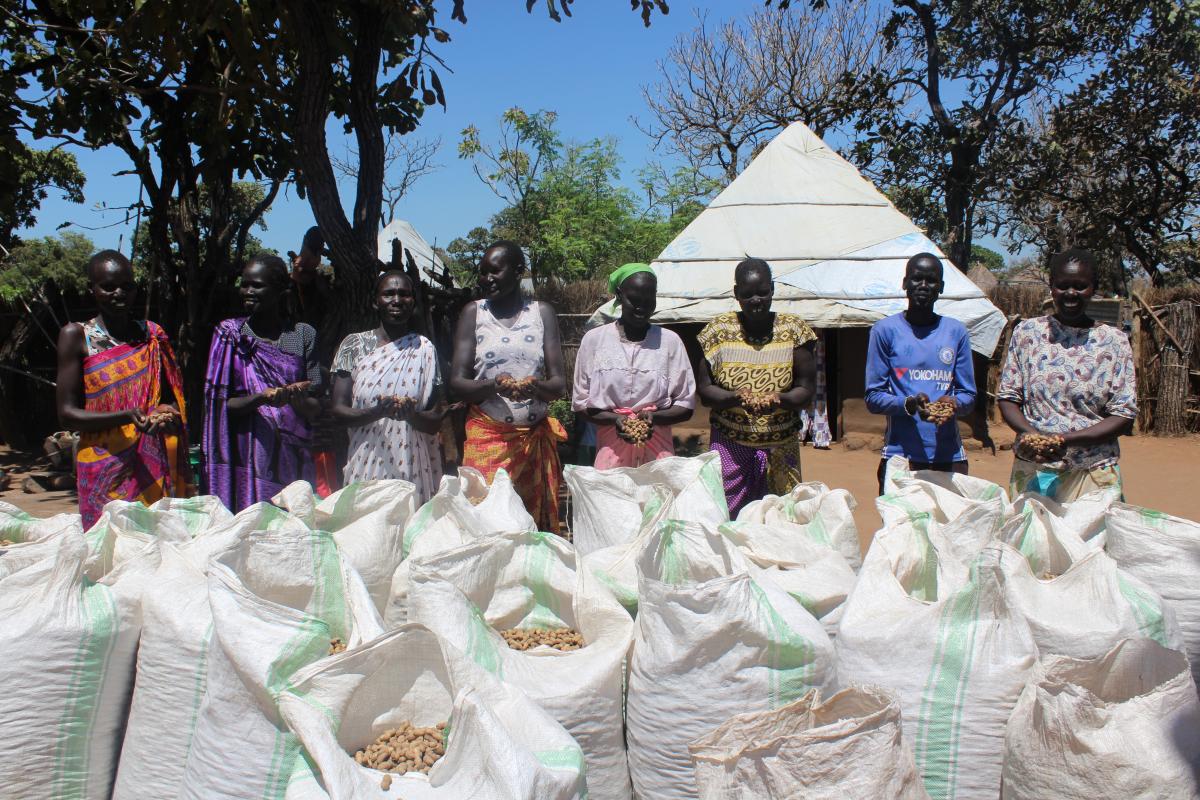
A fivefold harvest excites refugee farmers
Sylvia NABANOBA | 14/11/2018
A group of women and a man stack groundnuts into 27 white sisal sacks in the small compound. The groundnuts had been put out to dry – a necessary stage in the post-harvest handling process that will prevent them from being affected by mould while in storage. This is the home of Akiit Deng Garang, a South Sudanese refugee staying in Ayilo II refugee resettlement in Adjumani, Northern Uganda. A widowed mother of six, Garang fled her home in South Sudan in 2014 due to war and was resettled in Ayilo II. She is now the group leader of the farmers’ group that has harvested the 27 bags of groundnuts. The group, which goes by the Dinka name Domwokok, comprises 26 members, only two of whom are men. Most of the women are widows or living on their own in Uganda, their husbands having stayed behind in South Sudan. It partly explains why when the Danish Refugee Council mobilised the Ayilo II community to form farmers’ groups that they would work with on an agricultural programme, there was little hesitation in this community. “Working together in a group is good because it unites us,” says Garang. “More importantly, it enables us to work for our families’ welfare together. We support each other.” Under the European Union Emergency Trust Fund’s Support Programme for Refugee Settlements in Northern Uganda, the Danish Refugee Council operates a livelihood programme aimed at enabling refugees and Ugandans from the host communities to achieve home-based food security and income. The Danish Refugee Council does this through offering agricultural and financial literacy training to communities as well as farm inputs that include seeds, hoes and pangas. “After training us, Danish Refugee Council gave us five sacks of groundnuts which we planted on a five-acre piece of land,” says Garang. “We have now harvested 27 bags out of that, and we are very happy.” Each refugee in Uganda is offered a small plot of land for setting up a shelter and carrying out gardening. However, Domwokok group needed a large piece of land, and they were lucky to get offered five acres, free of charge, by a Ugandan landlord. To enable refugees get land for agriculture, the Danish Refugee Council reaches out to the local Ugandan community which owns most of the land in the area and requests landlords to free up some land on which the refugees can farm. Danish Refugee Council tries to make this acceptable by involving the local Ugandan population in its activities, something that helps to foster peaceful co-existence between the refugees and their hosts. So now that the harvest is in, what next for Domwokok group? “We will sell off 17 bags and keep the rest for re-planting,” says Garang. Having realised that groundnuts can withstand the largely dry weather in Adjumani, the group hopes to capitalise on that and expand production. Sticking to groundnuts may take away their worries about the weather, but may not solve some of the other challenges the group faced in the first season. “The soil here is mostly rocky – it is hard, dry and not fertile,” Garang explains. “It is also infested with termites which attack the crops.” Nevertheless, the group has a lot to look forward to. Groundnuts are marketable in the region, as they are one of the staple foods. A 100kg sack costs about UGX100,000 (USD28). In addition, it is hoped that the group will become a supplier of groundnut seeds to other farmers, as well as the Danish Refugee Council itself. Domwokok Group is confident that they have the financial skills to manage the proceeds from the sale of their current harvest as well as those that will come in the future. “We have received training in financial management, records keeping and saving,” chips in Nyanyok Dupel, a member of the group. The group actually has a financial arm, too, in the form of a village savings and loans association through which each group member saves some money per week. They have so far saved UGX3,590,000 (USD997), which members are free to borrow and return at a low interest. The Danish Refugee Council works with 244 such groups in Adjumani district, made up of both refugees and Ugandans. In Yumbe, another district hosting refugees, the organization works with 234 groups.
-
Forest Sector Support Department boosted by GIS training
Rachael AYEBALE | 13/11/2018
Ministry of Water and Environment (MoWE) Forest Sector Support Department (FSSD) department has a mandate to monitor all tree growing in the country. Tasked with this mandate, there was a big gap in the ability to have a representation of the tree growing coverage in the country. A needs assessment exercise was thus conducted at the department, and a course in Geographical Information Systems (GIS) was recommended for the department, to improve forest cover reporting for the department. This course instructs on how to capture, store, manipulate, analyze, manage, and present spatial or geographic data. It has been a saviour for the department. Most staff did not know what GIS is and how it can be used to improve reporting. Now they all understand the GIS component and appreciate how it eases their work in reporting forest coverage developments in Uganda. “Most of the time when we went to the field, we just came back with word reports without any physical evidence to back it up,” Irene Nanyondo, a forestry officer with the Ministry of water and environment mentions. “After this training, we now endeavor to carry GPS equipment and report using maps,” she adds. This implies that the department is now closer to where they envision it. A one stop center for all forestry coverage needs. The department has also now set up a GIS unit that is fully functional although faced with a few challenges such as lack of up to date equipment. Charles Byaruhanga, the principal Forestry officer intimates,” there is a big change in our work after this training. Now we can use this knowledge to collect data and report on the data.” Joseph Agaba, the FSSD department Economist and also training beneficiary, is very appreciative of the training they received. He feels the training was very essential for them by nature of the work they do in forestry cover reporting. “We were unable to produce maps to report on our work. But now we can easily produce maps, based on GPS points which has greatly improved our reports quality,” Joseph mentions. Recently after the Bududa landslide saga, the department was requested to provide aerial imagery of the area which they were able to provide. The local government after noting the very vivid reports provided by the department, requested the department to source for a trainer to also train them in geographical information systems. ‘’We are really very great full to the SDHR project that ensured we got this training.’’ And for all the trainings they have offered us, we appreciate. Adds Charles. ‘The trainer that trained us in GIS was very knowledgeable and we commend Enabel for sourcing the best trainers to train us,’’ Joseph concludes.
-
Health and safety now a priority for St Josephs VTI work spaces
Rachael AYEBALE | 08/11/2018
St Joseph’s Vocational Training Institute was once in an appalling security situation. The institute no formalized occupational health and safety management plans. There were no emergency exits in their workshops, they had no protective gear such as helmets, overalls, steel cap boots and so on. The institute had multiple entry points and thus anyone could get in and out of the institute without notice. The cooking areas were in dire state, food handling was inefficient, there were no emergency kits such as fire extinguishers and first aid boxes, waste management was lacking, sanitation facilities were lacking and so on. Following the analysis exercise of the organizational environment in occupational health and safety at the institute, a course in Occupational Health and safety among other interventions was recommended. OHS training participants tour the institute workshop to identify health and safety risks This course focuses on the social, mental and physical well-being of workers in all occupations raising awareness on unhealthy or unsafe working conditions thus aiming at decreasing work-related accidents and diseases. “The risks have so far been cut to over half,” As Geoffrey Oromcam the course trainer confirms after a tour of the institute workshops. There is now only one entry point to the institute with a fence built around the institute and only one open gate. Workshop lay out has improved at the institute. There are signs on safety in place in the workshops, garbage disposal has greatly improved with colored bins put in place, and emergency exits have been put in place in workshops among other changes. Tumusiime Edward Moses a participant in the training says, “I have at least changed how I was operating. I didn’t have any fire protection equipment, but now I do, although using manual methods such as sand.’’ “I have also trained my staff on how best to act in case of an emergency.’’ He adds. Muhangi Peter, who works as an instructor in the mechanical department adds onto Edwards testimony that he has learnt how to use PPEs (personal protection equipment), and to identify hazards in the workshop. He also agrees that there are numerous safety hazards in their workshops but now that they can identify them, the problem is half way solved. Magezi Francis, an instructor in Mechanical engineering at the institute also has a lot to say about the training. He has learnt how best to use PPEs. To himself and his students, personal safety comes first. Musinguzi Solomon proudly talks about how this training has improved on his work. “This training has helped me a lot. If you visit my workshop now, you will find it very organized,’’ he adds. However, to some beneficiaries of the training, change is yet to come. “If you visited my workshop now, it is in a mess, but after this training today, I am going to sit down and put it in order in as far as safety is concerned,” says Ben Mulogwa an MCP at the institute. On a whole, the knowledge has been passed on to the training participants. Despite the challenges the participants are faced with, they are optimistic and will do whatever they can to ensure they improve safety in the workshops to reduces health risks to them and their students.
-
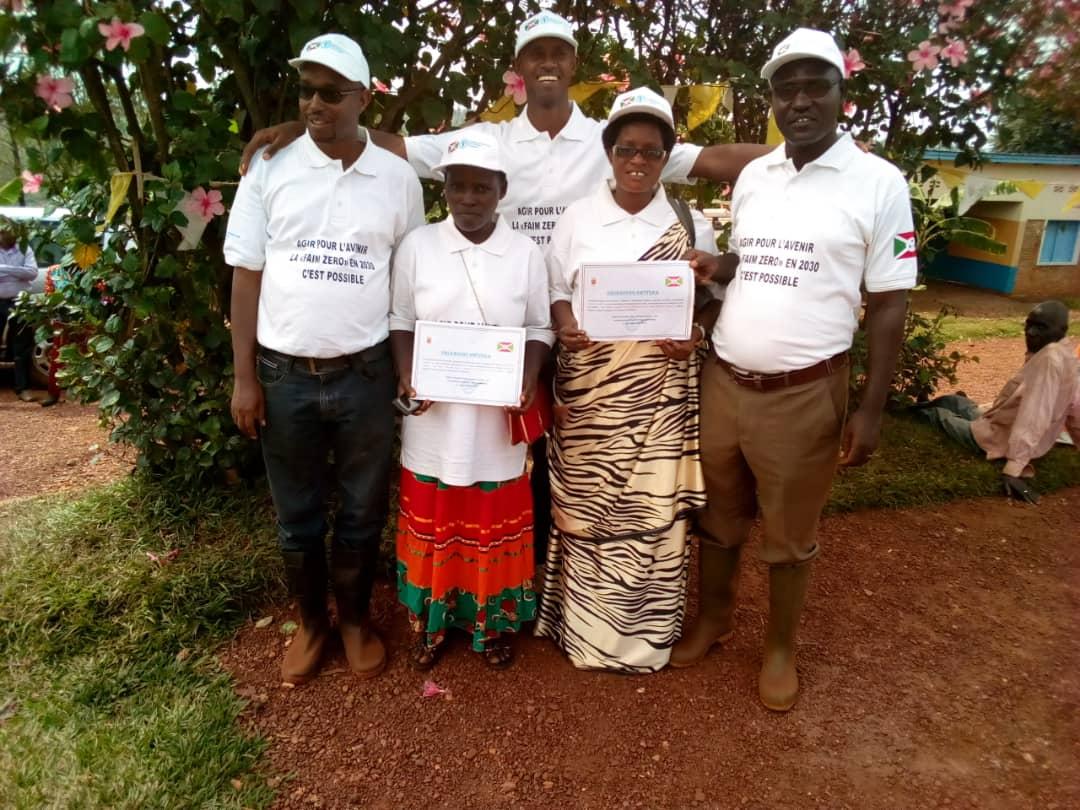
Enabel > PAIOSA : recompensé à la Journée Mondiale de l’Alimentation à Bwambarangwe (Province Kirundo)
Pascale LEPOINT | 07/11/2018
Participation d’Enabel Burundi à la Journée Mondiale de l’Alimentation du 16 Octobre 2018 à Bwambarangwe (Province Kirundo) avec, parmi les 4 meilleurs producteurs primés par le Ministre Dr. D-G. Rurema de l’Environnement de l'Agriculture et de l’Elevage, 2 facilitateurs CEP encadrés par PAIOSA / Enabel Burundi dans le cadre des Champs Ecoles PaysansLégende: Claudine NIZIGIYIMANA et Alphonsine MUKAREMERA les 2 facilitatrices maïs primées, entourées, de gauche à droite, par Ernest CISHAHAYO agent CEP Antenne PAIOSA/Bugesera, Bernard BIZOZA, Chef d’Antenne PAIOSA/Bugesera et Herménégilde MANYANGE, Point Focal MINEAGRIE/PAIOSA
-
PARCOURS D’INTEGRATION SOCIO PROFESSIONNELLE VISANT L’EMPLOI
Michael MALEMBA | 06/11/2018
Le programme vient d’impulser depuis septembre de cette année au centre d’application de DON BOSCO la filière de Mécanique moto pour des jeunes en rupture familiale et scolaire issus des communautés. Pour ces jeunes non diplômés, sans formation et sans emploi, cette opportunité constitue une aubaine pour se reconstruire et connaître un futur plus prometteur.Le programme appuie cette filière via le renforcement des capacités du personnel, la construction d’un nouvel atelier, la dotation en équipements et outillage, en vêtements de travail/sécurité, des motos neuves et usagées pour créer les conditions réelles d’un atelier de mécanique : ce qui permettra aux jeunes d’acquérir les compétences techniques, les gestes et attitudes propres au métier de mécanicien moto. 26 jeunes vont bénéficier d’un parcours d’intégration socio professionnelle encadré par des formateurs artisans durant 9 mois à raisons de 30 heures par semaine ; répartis en 20H de pratique réelle du métier en atelier et 10 H de cours généraux (maths simples, français, entrepreneuriat, code de la route). Le Centre d’application Don Bosco est appuyé par le programme, pour cette filière dans le non formel, unique dans le Kasaï Oriental. Ce qui permettra à ces 26 jeunes bénéficiaires apprenants d’acquérir les compétences métier nécessaires à l’exercice de la profession. Un accompagnement à l’auto-emploi sera mis en place à la fin de leur parcours d’intégration avec pour objectif unique de les aider à créer leur propre emploi. Les jeunes apprenants seront accompagnés par l’U.F.E. (Unité Formation Emploi) adossée à l’établissement afin de faciliter leur insertion professionnelle. Le programme dotera chaque jeune d’un « KIT d’installation » lui permettant d’être rapidement actif à l’issue de leur apprentissage au bénéfice des clients usagers des deux roues dans la ville de Mbuji-Mayi.
